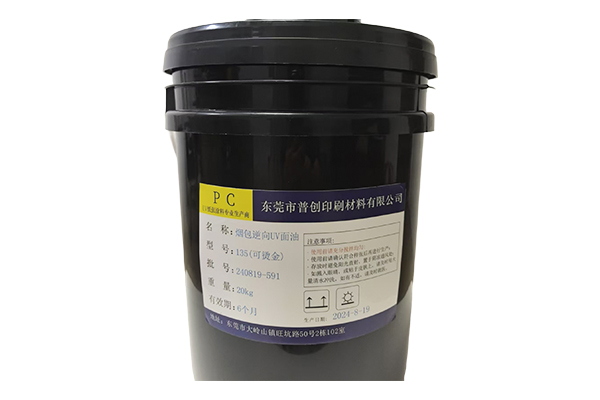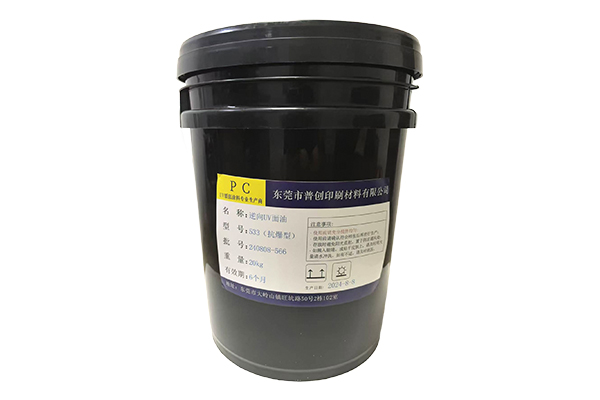When using film reverse UV varnish in a low temperature environment, what changes will occur in the curing efficiency and film flexibility?
Release Time : 2025-05-15
The influence of low temperature environment on the curing efficiency and film performance of film reverse uv varnish is an important research direction in the printing field. From the perspective of molecular motion, low temperature will significantly reduce the activity of photoinitiators and the fluidity of resin systems, resulting in multiple changes in the curing process. When the ambient temperature is lower than 15°C, the rate of free radical decomposition of photoinitiators decreases by about 30%-50%, which directly slows down the cross-linking reaction rate of prepolymers and monomers in film reverse uv varnish. At the same time, low temperature will hinder the evaporation of solvents, and residual solvents may swell with the cured film layer, further interfering with the orderly arrangement of molecular chains. In actual production, this efficiency reduction is often manifested as sticky surfaces and insufficient hardness of the cured film layer, and even adhesion in the subsequent die-cutting process.
The reduction in curing efficiency is closely related to the matching of light-curing equipment. In traditional UV curing equipment, the luminous efficiency of mercury lamps will fluctuate due to the unstable temperature of the lamp tube in a low temperature environment, resulting in a reduction in effective ultraviolet light energy output. Studies have shown that when the ambient temperature drops from 25°C to 5°C, the 365nm wavelength light intensity of the mercury lamp may drop by 15%-20%, which makes the photon energy absorbed by the varnish insufficient and cannot fully stimulate the cross-linking reaction. To address this problem, some companies have tried to increase the power of the UV lamp or extend the irradiation time, but excessive energy may cause the film substrate to deform due to heat, especially PE and PVC films that are sensitive to temperature, which are prone to shrinkage exceeding the standard (more than 1.5%), which in turn affects the accuracy of the printed product.
The change in the flexibility of the film layer is closely related to the formation mechanism of the polymer network. Under low temperature conditions, the mobility of the prepolymer molecular chain is limited, and the cross-linking reaction is more likely to form a tight but inelastic network structure. Fourier transform infrared spectroscopy (FTIR) analysis shows that in the low-temperature cured film layer, the hydrogen bond association degree of polyurethane acrylate increases by about 20%, resulting in the glass transition temperature (Tg) rising to 45-50°C, while the Tg of the room temperature cured film layer is usually 30-35°C.
This change makes the film layer more prone to cracking in bending tests (such as 180° folding), especially for coatings with a thickness of more than 8μm, where the cracking rate increases by 40%-60% compared to the normal temperature state. For packaging films that require subsequent composite processing, this increased brittleness may lead to stress concentration between the composite layers, affecting the puncture resistance of the finished product.
The synergistic effect of ambient humidity in low temperature scenarios cannot be ignored. When the low temperature environment is accompanied by high humidity (such as relative humidity>70%), the moisture in the air will be adsorbed on the surface of the film to form a nano-scale water film, hindering the spreading of film reverse uv varnish. Contact angle measurements show that under low temperature and high humidity conditions, the contact angle of varnish on PET film increases from 35° at room temperature to 48°, and the leveling time is extended by 2-3 times. At the same time, moisture may react with amine additives in the varnish, consume part of the initiator, and cause a decrease in the degree of curing (from 95% to below 80%). This dual effect not only further reduces the curing efficiency, but also generates microbubbles inside the film layer. Under a microscope, pores with a diameter of 50-100μm can be seen, which seriously affects the appearance quality and functionality.
The process optimization strategy needs to be approached from both the material and equipment aspects. On the material side, the temperature sensitive range of the initiation efficiency can be widened to 5-10°C by introducing a low-temperature photoinitiator (such as a compound system of 2-hydroxy-2-methyl-1-phenyl-1-propanone and thioxanthone). At the same time, adding 3%-5% of an acrylate active diluent (such as tripropylene glycol diacrylate) can reduce the viscosity of the system (from 2000mPa·s to below 1200mPa·s) and improve low-temperature fluidity. On the equipment side, a preheating roller (temperature setting 30-40°C) can be used to preheat the film to raise the surface temperature of the substrate to about 20°C. Combined with the precise temperature control function of the LED-UV curing equipment (peak wavelength 395nm), the curing efficiency can be restored to more than 85% of the normal temperature state, while avoiding overheating and deformation of the substrate.
The improvement of film flexibility depends on the dynamic regulation of the cross-linked network. By adjusting the prepolymer composition and increasing the proportion of acrylate monomers containing long-chain alkyl groups (such as C12-C16) (from 15% to 25%), a "flexible segment" can be introduced into the cross-linked network, reducing Tg to 38-42°C. Dynamic mechanical analysis (DMA) shows that the storage modulus (G') of the optimized film at -10°C is reduced from 1.2×10^9Pa to 8.5×10^8Pa, and the elongation at break is increased from 45% to 68%, significantly improving low-temperature brittleness. In addition, post-curing treatment processes (such as hot air circulation baking at 60°C for 10 minutes) can promote secondary cross-linking of incompletely reacted functional groups, while relieving internal stress, reducing the crack incidence of the film layer in low-temperature bending tests to less than 15%.
The future direction of technological development focuses on intelligence and greening. The intelligent temperature-controlled UV curing system can adjust the lamp power and conveying speed in real time according to the ambient temperature by integrating infrared sensors and PID controllers, ensuring that the curing energy density is stable at 800-1200mJ/cm². The development of bio-based film reverse uv varnish (such as epoxy acrylate prepolymer based on vegetable oil) can not only reduce the glass transition temperature of the system, but also increase the curing efficiency at low temperatures by 10%-15%, while meeting the safety standards for food contact materials. With the deep integration of material science and optomechanical integration technology, the application problems of film reverse uv varnish in low-temperature environments will gradually be systematically solved, providing a new path for the energy-saving and refined development of the packaging and printing industry.






